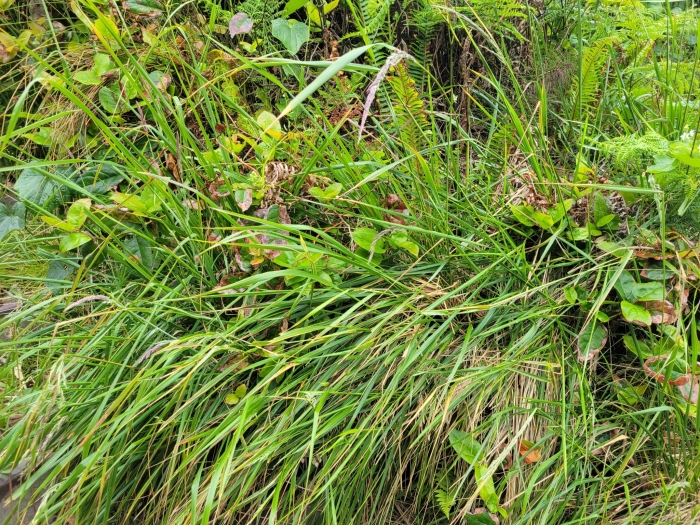Pacific Reedgrass
(Calamagrostis nutkaensis)
Pacific Reedgrass (Calamagrostis nutkaensis)
/
/

Peter Brastow
CC BY 4.0
Image By:
Peter Brastow
Recorded By:
Copyright:
CC BY 4.0
Copyright Notice:
Photo by: Peter Brastow | License Type: CC BY 4.0 | License URL: http://creativecommons.org/licenses/by/4.0/ | Rights Holder: Peter Brastow | Publisher: iNaturalist | Date Created: 2021-06-24T09:07:29-07:00 |
































Estimated Native Range
Summary
Calamagrostis nutkaensis, commonly known as Pacific reedgrass or Nootka reedgrass, is a perennial bunchgrass that is native to coastal wetlands, meadows, and dune ecosystems along the western coast of North America, from Alaska to central California. It thrives in moist environments, often forming dense clumps in open areas where it can receive ample sunlight. Pacific reedgrass typically grows to a height of over one meter, with thick tufts of stems and several flat, grass-like leaves that can be up to a centimeter wide. The inflorescence is characteristically narrow and sparse, contributing to its subtle visual appeal. This grass is particularly adapted to environments with high humidity and salt spray, often found in coastal regions.
Pacific reedgrass is valued for its ability to stabilize soil and is used in restoration projects, especially in coastal habitats. It is also appreciated for its low maintenance requirements and is suitable for planting in naturalistic garden settings, where it can provide texture and movement. While it can tolerate a range of light conditions, from full sun to part shade, it prefers moist soils with good drainage. It is not commonly afflicted by diseases or pests, making it a resilient choice for challenging coastal environments. However, gardeners should be aware that it can spread vigorously and may require management to keep it in check.CC BY-SA 4.0
Pacific reedgrass is valued for its ability to stabilize soil and is used in restoration projects, especially in coastal habitats. It is also appreciated for its low maintenance requirements and is suitable for planting in naturalistic garden settings, where it can provide texture and movement. While it can tolerate a range of light conditions, from full sun to part shade, it prefers moist soils with good drainage. It is not commonly afflicted by diseases or pests, making it a resilient choice for challenging coastal environments. However, gardeners should be aware that it can spread vigorously and may require management to keep it in check.CC BY-SA 4.0
Plant Description
- Plant Type: Grass
- Height: 3-5 feet
- Width: 2-3 feet
- Growth Rate: Moderate
- Flower Color: N/A
- Flowering Season: Spring, Summer
- Leaf Retention: Evergreen
Growth Requirements
- Sun: Full Sun, Part Shade
- Water: Medium
- Drainage: Medium
Common Uses
Bank Stabilization, Bird Garden, Border Plant, Deer Resistant, Drought Tolerant, Erosion Control, Low Maintenance, Rock Garden
Natural Habitat
Coastal wetlands, meadows, and dune ecosystems
Other Names
Common Names: Nootka Reedgrass
Scientific Names: Calamagrostis nutkaensis , Deyeuxia nutkaensis , Calamagrostis aleutica , Calamagrostis albicans , Calamagrostis aleutica var. patens , Deyeuxia breviaristata , Calamagrostis albescens , Calamagrostis kastalskyi , Calamagrostis pallida , Deyeuxia aleutica , Deyeuxia columbiana
GBIF Accepted Name: Calamagrostis nutkaensis (J.Presl) Steud.